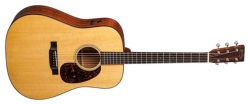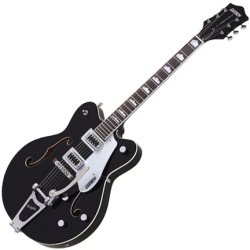4.Fender American Vintage ’65 Jazzmaster
(MSRP $2,875)
I’m falling in love again. Full disclosure: the Fender Jazzmaster has been my main instrument for nearly 20 years. I fell head over heels the first time when I lucked into finding a refinished 1959 model back in the early ’90s. When I went on tour soon afterward, I picked up a Japanese reissue to use as a back-up. The reissue was deeply disappointing – style over substance in the worst way. Eventually, I managed to trade in the reissue … toward another refinished ‘59.
I’d long wanted to find another Jazzmaster to play at gigs so I could leave my increasingly valuable vintage models at home, but nothing I’ve played has tempted me … until now. Playing unamplified, I noted that the neck is a little shorter and fatter than my ’59s. When I plugged into my own Vox AC-30 amp, I was taken aback by the richness of the tone. My ’59s have a brassy, somewhat brittle top-end presence, but not much low-end depth. The ’65 has the bright, brassy top-end, but the sound is richer and fatter. When I added some distortion from a vintage Tube Screamer and a bit of reverb, it just sounded enormous.
Ultimately, I found the reissue to be more playable than my ’59s, mostly because of the slightly shorter neck. I have small hands, and the ’50s Jazzmaster frets are very wide. I’ve probably adapted my playing to the wide frets, so it’s refreshing to play an instrument that is more comfortable in my hands. I was also pleased that it held tune remarkably well – even when I flailed the tremolo Kevin Shields-style. If you are looking for a Jazzmaster and you don’t want to break the bank on a true vintage model, this reissue is an excellent choice. – JOHN P. STROHM [The Blake Babies, The Lemonheads, Velo-Deluxe]
5. Martin D18E Retro Acoustic/Electric Guitar
(MSRP $3,399)
It was only a matter of time before Martin figured out how to incorporate a technological advancement that was on the same level of excellence as the company’s legendary guitars. Martin’s D18E Retro features the Fishman F1 Aura + electronics system, which has vintage guitar presets that were created using a vintage 1937 D-18 played through various vintage and boutique microphones. The sounds were created with the input and mic collection of noted Nashville engineer Bil VornDick (Bob Dylan, Alison Krauss).
First of all, in a strictly unplugged setting, the guitar sounds great, as do most Martins. Rarely does this company let anything through the doors that isn’t high quality, with the hope that all their guitars will age wonderfully, and many of them do. With a Sitka spruce top, mahogany back and sides, and ebony fingerboard on a Performing Artist Series neck, the one we tested was a little stiff, but it was right out of the box and needed some exercise. Tone and balance were great, and it was easy and comfortable to play. Again, it’s a Martin.
Electronically, the new system is a great advance, though there’s a learning curve at first, especially for players whose ears might not be all that attuned to differences in timbre and frequency. The guitar features an “Easy Mode,” which offers a choice of three different settings that are based on the sounds of vintage mics. But you can just play with the pickup’s normal sound using the Easy Mode if you prefer. The “Performance Mode” feature, however, allows for more in-depth shaping of the guitar’s tone and takes a little work and patience when trying to dial in what you want to hear. In the end, though, it’s worth the effort if you’re a real tone chaser.
This guitar can be found at a street price of about 25 percent less than its list price of $3,399, which is actually pretty reasonable considering the capabilities of this guitar. Plan to spend some time working with the electronics if you go to a store to check one out, and make sure to find a salesman who really knows what the guitar is about. – RICK MOORE
6. Gretsch G5422TDC Electromatic Hollow Body
(MSRP $1,250)
The Gretsch name has been a mainstay in guitars for more than half a century, thanks largely to the late Chet Atkins, a Gretsch player who will go down in history as one of the greatest guitarists ever. Other players in the 1950s like Eddie Cochran and Duane Eddy also played Gretsches, and British players like George Harrison, Brian Jones and Pete Townshend followed suit. But with the notable exception of Brian Setzer, Gretsch guitars in the hands of groundbreaking stars became scarce in the era of Les Pauls and Fenders and everything after.
The Gretsch name is still around, though, and the company continues to develop new products. One of these is the Gretsch G5422TDC Electromatic Hollow Body. The guitar is a double-cutaway with f-holes and Filter’Tron dual-coil pickups, which utilize a large ¼” alnico magnet (twice as large as a standard PAF magnet) and larger pole screws, which is supposed to result in a thicker tone. We tested a black G5422TDC at Nashville’s Myrmidon Studios through a modified Fender Princeton amp with a 12” Mesa Boogie speaker.
Spending quite a bit of time using different settings on the amp with different pickup combinations, we were pretty pleased with the sound, though it was evident that a player would have to work with the blending of the pickups and master volume, and his or her particular amp, to find their own sweet spot, as the pickups seemed maybe a little too thick at times. The guitar’s Bigsby tremolo, a brand that has been alternately loved and reviled by the guitar community for decades, worked just fine when used for the things it’s best-known for, namely, adding the vibrato shimmer to single notes and chords and giving a more radical bite to chord solos ala Setzer. It always came back in tune, surprising since this was a just-out-of-the-box axe.
The knobs on the G5422TDC can be a little confusing at first for someone who isn’t used to the Gretsch knob configuration of the master volume on the lower left of the body, with volume controls for the two pickups and the tone control knob on the lower right and the three-position switch on the upper left. But once a player has his or her settings pretty much dialed in, the master volume shouldn’t have to be adjusted very often. The guitar has soundpost bracing, a maple neck, bound rosewood fingerboard with 22 medium jumbo frets and hump-block pearloid inlays. The guitar has vintage-style open-back tuners, chrome-plated hardware, a silver plexi pickguard and a rosewood-based Adjusto-Matic bridge.
The G5422TDC lists for $1,250 although they’re available for a street price of several hundred dollars less. This is a decent enough guitar, but is especially good for someone who just wants to add a Gretsch to their collection but has been scared off by the price tag of, say, a new White Falcon at $3,000+. The guitar is available in black, red and walnut satin. – RICK MOORE





5 Comments
Leave a Reply